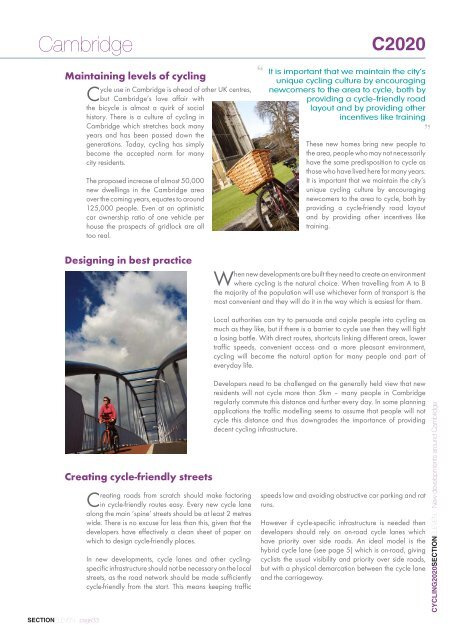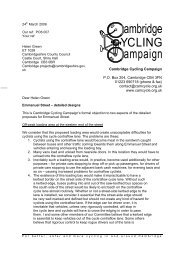Printable PDF version - Cambridge Cycling Campaign
Printable PDF version - Cambridge Cycling Campaign
Printable PDF version - Cambridge Cycling Campaign
- No tags were found...
Create successful ePaper yourself
Turn your PDF publications into a flip-book with our unique Google optimized e-Paper software.
<strong>Cambridge</strong>Maintaining levels of cyclingCycle use in <strong>Cambridge</strong> is ahead of other UK centres,but <strong>Cambridge</strong>’s love affair withthe bicycle is almost a quirk of socialhistory. There is a culture of cycling in<strong>Cambridge</strong> which stretches back manyyears and has been passed down thegenerations. Today, cycling has simplybecome the accepted norm for manycity residents.The proposed increase of almost 50,000new dwellings in the <strong>Cambridge</strong> areaover the coming years, equates to around125,000 people. Even at an optimisticcar ownership ratio of one vehicle perhouse the prospects of gridlock are alltoo real.“C2020It is important that we maintain the city’sunique cycling culture by encouragingnewcomers to the area to cycle, both byproviding a cycle-friendly roadlayout and by providing otherincentives like trainingThese new homes bring new people tothe area, people who may not necessarilyhave the same predisposition to cycle asthose who have lived here for many years.It is important that we maintain the city’sunique cycling culture by encouragingnewcomers to the area to cycle, both byproviding a cycle-friendly road layoutand by providing other incentives liketraining.“Designing in best practiceWhen new developments are built they need to create an environmentwhere cycling is the natural choice. When travelling from A to Bthe majority of the population will use whichever form of transport is themost convenient and they will do it in the way which is easiest for them.Local authorities can try to persuade and cajole people into cycling asmuch as they like, but if there is a barrier to cycle use then they will fighta losing battle. With direct routes, shortcuts linking different areas, lowertraffic speeds, convenient access and a more pleasant environment,cycling will become the natural option for many people and part ofeveryday life.Creating cycle-friendly streetsCreating roads from scratch should make factoringin cycle-friendly routes easy. Every new cycle lanealong the main ‘spine’ streets should be at least 2 metreswide. There is no excuse for less than this, given that thedevelopers have effectively a clean sheet of paper onwhich to design cycle-friendly places.In new developments, cycle lanes and other cyclingspecificinfrastructure should not be necessary on the localstreets, as the road network should be made sufficientlycycle-friendly from the start. This means keeping trafficDevelopers need to be challenged on the generally held view that newresidents will not cycle more than 5km – many people in <strong>Cambridge</strong>regularly commute this distance and further every day. In some planningapplications the traffic modelling seems to assume that people will notcycle this distance and thus downgrades the importance of providingdecent cycling infrastructure.speeds low and avoiding obstructive car parking and ratruns.However if cycle-specific infrastructure is needed thendevelopers should rely on on-road cycle lanes whichhave priority over side roads. An ideal model is thehybrid cycle lane (see page 5) which is on-road, givingcyclists the usual visibility and priority over side roads,but with a physical demarcation between the cycle laneand the carriageway.CYCLING2020SECTIONELEVEN.. New developments around <strong>Cambridge</strong>SECTIONELEVEN.. page33







